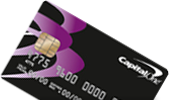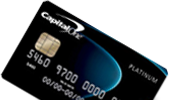Applied for a credit card and been rejected? FREEZE! Assess why you've been knocked back, then either find cards that fit your profile or try to rebuild your credit rating using the top 'bad credit' credit card and always pay it off in full.
This is a full guide to that, plus how to avoid the dreaded rejection spiral, and improve your credit history.
In this guide
Best Buys: Cards to rebuild score
Q. Why am I being rejected?
 The financial crisis and recession that's followed has seen banks wildly change the way they decide to lend money; essentially they now want to take less risks with their cash. This means if you used to get credit cards fairly easily, you may now struggle.
The financial crisis and recession that's followed has seen banks wildly change the way they decide to lend money; essentially they now want to take less risks with their cash. This means if you used to get credit cards fairly easily, you may now struggle.
Yet whether you get given new credit isn't a simple calculation based on how much you earn or some mythical 'universal credit rating' or blacklist. Lenders 'score' you to predict your likely behaviour, but these scoring systems are never published and differ lender-to-lender, and product-to-product.
The whole game of credit scoring is a convoluted one, and to understand how it works, and what the banks judge you on, read the full Credit Rating guide. Importantly always check the information held about you with the three credit reference agencies is correct, as this plays a big part in lenders' decisions (you can do it for free).
If you've been rejected by all and sundry, then it's likely you've got a poor credit score or a problem with your credit history. Conversely, if you've always been accepted in the past and just been rejected once then it's possible you just don't fit one particular card company's customer profile.
If you have had the interest rate you pay on an existing credit card increased, read the Ratejacking guide to rejecting credit card rate hikes.
Q. What to do when I'm rejected?
Crucially...
If you're rejected - STOP applying. First check your file's correct.
If it is, consider getting a special 'poor credit' card
 Freeze! Apply for too many cards and receive multiple rejection letters in a short period and you could shoot your credit rating in the foot for years. This is the dreaded 'rejection spiral'!
Freeze! Apply for too many cards and receive multiple rejection letters in a short period and you could shoot your credit rating in the foot for years. This is the dreaded 'rejection spiral'!
Here's how it works...
- You apply for a new credit card and get rejected.
This could be for a number of reasons: a bank error; incorrect info on your credit file, or you've applied for a card intended for those with an 'excellent' score when you only have a 'good' score (sadly, many lenders do not publish their criteria in advance of application). - You apply elsewhere, and get rejected again.
As well as the reason you were rejected in the first instance, you now have an extra search on your credit file, which counts further against you when banks make their decision.
You'll now have TWO recent searches on your file, and NO new cards. If you were unable to get credit before, now it will be even more difficult - maybe impossible for a while.
Multiple rejected applications can mess up your score for an age as more applications mean more searches, which compounds the problem.
If you haven't applied for a while, or have applied once and been knocked back, you should first check your file for free, and secondly call lenders you plan to apply to in advance to check what kind of customer they're after.
Q. How do I get a card to use?
Once you've worked out whether it was a one-off rejection or down to a poor credit score, you need to plan how to act next. If you need a card for borrowing (either a 0% card for new spending or a top balance transfer deal), use this quick three step scheme:

Minimise the new credit you need
If you're after a card to reduce the cost of existing debts, first see if you can achieve the same using the plastic you already have. A special technique can enable you to reduce the interest you pay on outstanding debts without applying for new cards (read the full Credit Card Shuffle guide)
After you've done it, you could have some credit cards with no debt on you should then check the APR on these if you require plastic to spend on. If your credit rating's a bit shabby, this could well be lower than anything you'll get on new cards you apply for.

Try and find a card that'll accept you
If you're still after a new credit stream, try the personalised credit card searches on comparison site Moneysupermarket*.
It asks 5 quick questions to assess your credit worthiness, then tries to match you up with the best card, using 'soft searches' of your credit file, which importantly don't leave a mark (hence don't hit future applications)
It's also worth taking a look at our quick Credit Checker. These are a bit rough so shouldn't be relied upon fully, but can give a decent indication of the cards you may get without doing a proper credit search

No luck? Avoid borrowing
If all your 'perfect matches' come with sky-high interest rates, then it's best you do everything you can to avoid borrowing money. Try our full Money Makeover to cut down on every expense and possibly boost your income, and do a proper budget.
If you're still struggling at this point, you may need to get professional debt help. For a step by step checklist of how to act, and a full listing of non-profit debt counselling agencies, read the Debt Problems guide.
Q. What's the best card to rebuild my score?
 If you can't get a card with decent rates or special deals, it's time to look at rebuilding your credit rating. One of the best ways to do this is by getting the right sort of credit card.
If you can't get a card with decent rates or special deals, it's time to look at rebuilding your credit rating. One of the best ways to do this is by getting the right sort of credit card.
By getting any kind of credit, and operating it perfectly (i.e never missing payments, always staying within limit), you can either build up a credit history from scratch, or remedy a tarnished one.
There are two main paths, depending on how bad your rating is in the first place. Before going any further though, there is a vital golden rule...
Strictly repay EVERY month, in FULL, so there's no interest cost.
Borrowing new debt on any of these cards will be hideously expensive and should be avoided at all costs. However, cleverly using one (or even two) of these cards for six to twelve months, spending a little every month and paying it off, can help clean up a muddied credit history, or build one from scratch.
Capital One ProgressInterest rate reduces the longer you hold the card

- Representative APR: 29.9% variable. Can drop to 17.9% over 36 months
- Required income: N/A
- Rate example: Official APR example
- Any restrictions? No CCJs or defaults in past 12 months
Aimed at people with an OK credit rating, the Capital One Progress card starts off by giving you a nasty 29.9% representative APR - always pay off in full to avoid. As you hold the card, this drops in stages (eg. to 27.9% after six months) until it hits 17.9% after three years - a pretty standard APR.
You've got a chance of getting this provided you haven't had any County Court Judgements (CCJs)/defaults in the past 12 months, and have operated credit cards without missing too many payments before, but a few penalties will be ok. If you're trying to build a history from scratch, or have had real problems in the past, then try one of the cards.
As long as you don't miss monthly payments or go over your limit, these interest rate cuts are guaranteed. This results in another boon; it accepts balance transfers (for a one-off fee of 3%). This means that after two years, for example, you'll be able to move debts which are lingering on even more expensive cards to Capital One at 21.9%
Capital One Classic Can get it even with CCJs

- Representative APR: 34.9% variable
- Required income: N/A
- Rate example: Official APR example
- Any restrictions? CCJs or defaults may be accepted, no bankruptcies
The Capital One* Classic card should be used as a credit rebuilding card. The rate is an enormous 34.9% so should be used as a credit rebuilding card, ie, spend then clear the card in full each month.
It's aimed specifically at borrowers who�ve incurred multiple charges, defaulted on debts or had CCJs (though will reject those made bankrupt in the past year).
It may also be an emergency tool for those facing repeated bank charges - put a little spending on this instead of from your bank account, to get that under the limit, then try and clear the card after (but keep to a tight budget & be careful).
There are a few alternatives for rebuilding bad credit - we've put in order of representative APR but as you should avoid ever paying interest, the rate�s not crucial: Barclaycard Initial* (29.9%, but won't accept CCJs in past 5 years), Aquacard* (35.9%) and Vanquis* (39.9%).
The last resort! Buy a prepaid cardIt's �60/year, but anyone is guaranteed to get it

- Application fee: �4.95
- Monthly fee: �4.95
- Spending fee: None
If you've been rejected for the 'expensive' cards above, there's a last resort option. The Cashplus Creditbuilder* is a prepaid card, meaning you have to load it with cash before spending, rather than having a credit facility, which costs �4.95. However, you cannot be rejected for it! There's no guarantee, but it's worth considering.
To help rebuild your credit rating, during your application click 'yes' when asked if you're interested in adding Creditbuilder. You'll then be charged a �4.95 monthly fee and as long as you pay the fee every month for a year, this info will be passed on to credit reference agency Experian. So you pay a �60 charge in �5 monthly instalments to be able to build your credit score. To get the facilty you need to provide proof of ID and address.
If you go this route you must...
NEVER EVER EVER miss a monthly payment.
It gets reported, leaving you in an even worse position
Crucially, no credit check is needed to get the card, so is open to absolutely all. After 12 payments, it should show on your credit history as a fully repaid loan agreement (as the charge is technically a loan), making you a more attractive customer to many companies, hopefully meaning you can apply for better credit card and loan deals. Though you are, of course, paying �65 for it!
If you're after the best value prepaid card, don't go for this, read our full Prepaid Cards guide. For more details on this, including pros and cons, read Cashplus Creditbuilder discussion.
Think before adding insurance
Payment protection insurance is commonly sold with credit cards - the idea is it'll make some payments for you, usually for a year, if you are unable to (eg, if you lose your job).
There have been a myriad of cases where it has been missold eg, borrowers didn't realise they were signing up for it, or it was totally unsuitable for them, and some big lenders have been fined.
The protection isn't always bad, though policies sold with cards are often overpriced (you pay a monthly amount depending on the size of your balance). If you want it, compare the lender's cover with standalone providers such as Paymentcare or Best Insurance.
Always be vigilant to check you aren't getting more than you bargained for when you fill in the application, then check your statement each month to check you aren't inadvertently paying for extras if you didn't ask for them.
Q. How else can I improve my chances?
While it's not an exact science, there are a number of specific things you can do as good practice to improve both your credit score and lenders' attitudes towards you. For an even more comprehensive list, read the full Credit Rating guide.
-
Get on the electoral roll.
If you're not on the roll, it's unlikely you'll get any credit. Immediately check if you are by calling your council. If you aren't eligible to vote (mainly foreign nationals), send all the credit reference agencies proof of residency and ask them to add a note to your file. -
Keep up payments and never be late.
Always try to follow at least the minimum repayment plan for your financial products (though paying more is preferable, see the Minimum Repayments guide). Defaulting or missing payments could cause problems that can cost you for years (though you may get past charges back, see Bank Charges Reclaiming article).
If you are in difficulties, the cliche 'contact your lender' is a good one, as it should attempt to help. Changing your repayment schedule is preferable to defaulting - and though it will hit your credit score, it's better than a CCJ against you. -
Dealing with defaults on your file.
One of the major problems people face are past debt defaults; these can easily hamper applications for new credit and, if they're genuine and fair, are tough to deal with. There are a few things to try though, particularly if the default is unfair (read Financial Fight Back guide).- Complain to the Ombudsman. First write to the company and complain the default isn't fair and lay out your terms. Ask it to wipe it from your file, which it can do if it's disputed. If that fails, complain to the Financial Ombudsman, the free independent arbiter of disputes, as it can rule that the default can be wiped.
- Negotiate with the lender. If you are prepared to settle the debt, either in part or in full, then you can enter a negotiation with whomever you owe the money. This can include a condition of settlement that the default is wiped off your credit file. Companies are allowed to do this for disputed defaults.
- Add a 'Notice of Correction'. If all else fails and you believe the default's justifiably unfair, add a notice of correction to the file explaining the problem eg. "It was a joint account and the debt was run by my ex-husband/wife once I no longer had access".
This will slow applications down, as most companies will look at it manually, but as a substantial default is likely to stop you getting credit anyway, that's usually not a problem, providing it helps.
-
Cancel unused credit cards, debts and accounts.
Access to too much credit, even if it isn't used, can be a problem. If you have a range of unused credit cards, cancel most of them; this lowers your available credit and should help (see the Cancel Old Cards article for full info on what to close when).
However long standing bank accounts with good credit histories can be a benefit to your credit score, so they're often best left open.












